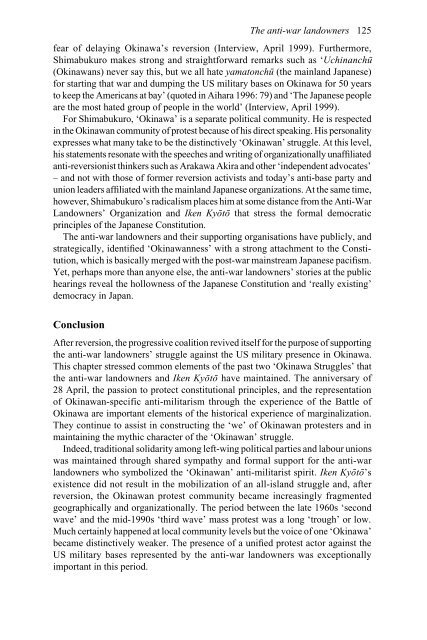Myth, Protest and Struggle in Okinawa
Myth, Protest and Struggle in Okinawa
Myth, Protest and Struggle in Okinawa
You also want an ePaper? Increase the reach of your titles
YUMPU automatically turns print PDFs into web optimized ePapers that Google loves.
fear of delay<strong>in</strong>g Ok<strong>in</strong>awa’s reversion (Interview, April 1999). Furthermore,<br />
Shimabukuro makes strong <strong>and</strong> straightforward remarks such as ‘Uch<strong>in</strong>anchū<br />
(Ok<strong>in</strong>awans) never say this, but we all hate yamatonchū (the ma<strong>in</strong>l<strong>and</strong> Japanese)<br />
for start<strong>in</strong>g that war <strong>and</strong> dump<strong>in</strong>g the US military bases on Ok<strong>in</strong>awa for 50 years<br />
to keep the Americans at bay’ (quoted <strong>in</strong> Aihara 1996: 79) <strong>and</strong> ‘The Japanese people<br />
are the most hated group of people <strong>in</strong> the world’ (Interview, April 1999).<br />
For Shimabukuro, ‘Ok<strong>in</strong>awa’ is a separate political community. He is respected<br />
<strong>in</strong> the Ok<strong>in</strong>awan community of protest because of his direct speak<strong>in</strong>g. His personality<br />
expresses what many take to be the dist<strong>in</strong>ctively ‘Ok<strong>in</strong>awan’ struggle. At this level,<br />
his statements resonate with the speeches <strong>and</strong> writ<strong>in</strong>g of organizationally unaffiliated<br />
anti-reversionist th<strong>in</strong>kers such as Arakawa Akira <strong>and</strong> other ‘<strong>in</strong>dependent advocates’<br />
– <strong>and</strong> not with those of former reversion activists <strong>and</strong> today’s anti-base party <strong>and</strong><br />
union leaders affiliated with the ma<strong>in</strong>l<strong>and</strong> Japanese organizations. At the same time,<br />
however, Shimabukuro’s radicalism places him at some distance from the Anti-War<br />
L<strong>and</strong>owners’ Organization <strong>and</strong> Iken Kyōtō that stress the formal democratic<br />
pr<strong>in</strong>ciples of the Japanese Constitution.<br />
The anti-war l<strong>and</strong>owners <strong>and</strong> their support<strong>in</strong>g organisations have publicly, <strong>and</strong><br />
strategically, identified ‘Ok<strong>in</strong>awanness’ with a strong attachment to the Constitution,<br />
which is basically merged with the post-war ma<strong>in</strong>stream Japanese pacifism.<br />
Yet, perhaps more than anyone else, the anti-war l<strong>and</strong>owners’ stories at the public<br />
hear<strong>in</strong>gs reveal the hollowness of the Japanese Constitution <strong>and</strong> ‘really exist<strong>in</strong>g’<br />
democracy <strong>in</strong> Japan.<br />
Conclusion<br />
The anti-war l<strong>and</strong>owners 125<br />
After reversion, the progressive coalition revived itself for the purpose of support<strong>in</strong>g<br />
the anti-war l<strong>and</strong>owners’ struggle aga<strong>in</strong>st the US military presence <strong>in</strong> Ok<strong>in</strong>awa.<br />
This chapter stressed common elements of the past two ‘Ok<strong>in</strong>awa <strong>Struggle</strong>s’ that<br />
the anti-war l<strong>and</strong>owners <strong>and</strong> Iken Kyōtō have ma<strong>in</strong>ta<strong>in</strong>ed. The anniversary of<br />
28 April, the passion to protect constitutional pr<strong>in</strong>ciples, <strong>and</strong> the representation<br />
of Ok<strong>in</strong>awan-specific anti-militarism through the experience of the Battle of<br />
Ok<strong>in</strong>awa are important elements of the historical experience of marg<strong>in</strong>alization.<br />
They cont<strong>in</strong>ue to assist <strong>in</strong> construct<strong>in</strong>g the ‘we’ of Ok<strong>in</strong>awan protesters <strong>and</strong> <strong>in</strong><br />
ma<strong>in</strong>ta<strong>in</strong><strong>in</strong>g the mythic character of the ‘Ok<strong>in</strong>awan’ struggle.<br />
Indeed, traditional solidarity among left-w<strong>in</strong>g political parties <strong>and</strong> labour unions<br />
was ma<strong>in</strong>ta<strong>in</strong>ed through shared sympathy <strong>and</strong> formal support for the anti-war<br />
l<strong>and</strong>owners who symbolized the ‘Ok<strong>in</strong>awan’ anti-militarist spirit. Iken Kyōtō’s<br />
existence did not result <strong>in</strong> the mobilization of an all-isl<strong>and</strong> struggle <strong>and</strong>, after<br />
reversion, the Ok<strong>in</strong>awan protest community became <strong>in</strong>creas<strong>in</strong>gly fragmented<br />
geographically <strong>and</strong> organizationally. The period between the late 1960s ‘second<br />
wave’ <strong>and</strong> the mid-1990s ‘third wave’ mass protest was a long ‘trough’ or low.<br />
Much certa<strong>in</strong>ly happened at local community levels but the voice of one ‘Ok<strong>in</strong>awa’<br />
became dist<strong>in</strong>ctively weaker. The presence of a unified protest actor aga<strong>in</strong>st the<br />
US military bases represented by the anti-war l<strong>and</strong>owners was exceptionally<br />
important <strong>in</strong> this period.
















